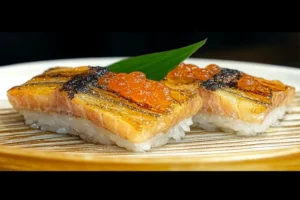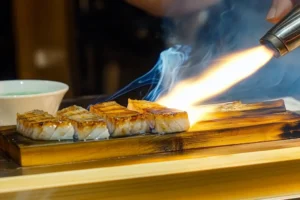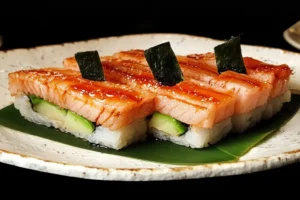Imagine taking a bite of sushi, but instead of the familiar coolness, you’re greeted with a warm, smoky burst of flavor that melts in your mouth. That, my friend, is the magic of Aburi. At its core, Aburi refers to a Japanese culinary technique where food—most famously sushi—is lightly seared with a flame or hot coals. This quick searing caramelizes the surface of the food, enhancing its natural flavors and adding a unique, smoky aroma.
But Aburi is so much more than just a cooking method—it’s an experience. It’s where tradition meets innovation, blending the fresh, delicate characteristics of raw fish with the savory depth of cooked ingredients. If you’re a sushi lover, you’ve probably heard whispers about seared sushi. But trust me, it’s worth shouting about.

The Origins of Unique Culinary Tradition
How Japanese Culture Shaped This Technique
Every food trend has a story, and seared sushi is no different. It traces its roots to Japan, a country that’s no stranger to culinary brilliance. While traditional sushi emphasizes raw fish and precision, seared sushi rose as a creative twist on this age-old favorite.
The exact origins are somewhat shrouded in mystery, but many credit chefs in Kyoto for popularizing Aburi as a way to cater to locals who preferred their fish slightly cooked. Over time, this method gained momentum, and soon, Aburi sushi became a staple in Japanese cuisine.
“Aburi isn’t just a method; it’s a bridge connecting tradition with modern tastes.”
From Local Flavor to Global Fame
It’s impossible to talk about Aburi without acknowledging the larger tapestry of Japanese culinary traditions. Japanese chefs are meticulous, often treating food preparation as an art form. Aburi aligns perfectly with this philosophy—it requires precision and creativity.
The flame-searing technique is a testament to how Japanese cuisine balances simplicity with depth. By slightly cooking the surface of fish while keeping the inside raw, chefs elevate each bite, giving you the best of both worlds.
A Modern Twist on Traditional Sushi
Why Flame-Seared Foods Are Gaining Popularity
In Japanese, “Aburi” literally means “flamed” or “seared.” It’s a straightforward term, but its implications are anything but simple. The idea is to use a flame to lightly cook the surface of the food, creating a textural contrast between the crispy, caramelized exterior and the tender, raw interior.
This technique is versatile and isn’t restricted to sushi. While sushi gets most of the spotlight, other dishes, like Aburi-style beef or vegetables, also benefit from this method.
Exploring Textures and Flavors That Delight
So, how exactly is Aburi prepared? Picture this: a skilled chef takes a slice of sushi-grade fish, lays it over rice, and holds a blowtorch above it. The flame dances across the surface, kissing it just long enough to add a golden, smoky sheen. Sometimes, sauces or garnishes are added before searing, intensifying the flavor profile.
What’s remarkable is that no two Aburi bites are exactly the same. The flame-searing process is an art in itself, with chefs using their instincts to achieve just the right level of doneness.
How seared sushi Differs from Traditional Sushi
The Role of Flame-Seared Technique
If you’re wondering how Aburi sets itself apart from regular sushi, the answer lies in the flame. Traditional sushi relies on raw fish for its fresh, unaltered taste. Aburi sushi, on the other hand, is all about transformation. The flame creates a charred layer that enhances umami (a savory taste) and adds a slightly smoky aroma.
This technique also makes Aburi more accessible to those who might be hesitant to eat raw fish. By lightly cooking the surface, it bridges the gap between raw and cooked dishes.
Comparing Textures and Flavors
One bite of Aburi, and you’ll notice the difference immediately. The texture is more complex, with a soft interior and a slightly crispy, caramelized exterior. The flavors are richer, too—imagine the sweetness of fresh fish combined with the smokiness of an open flame.
Traditional sushi is subtle and pure; seared sushi is bold and indulgent. Both have their charm, but seared sushi feels like a celebration on your palate.
“Think of Aburi as sushi’s adventurous cousin—familiar, yet full of surprises.”
Must-Try Dishes for a Foodie Adventure
Aburi Sushi: A Must-Try Experience
When people think of Aburi, sushi is usually the first thing that comes to mind. Aburi sushi comes in many varieties, from classic salmon and tuna to luxurious options like fatty toro (tuna belly).
What sets Aburi sushi apart is how it marries the delicate nature of sushi with the boldness of grilled dishes. Each piece is like a tiny masterpiece, designed to wow your taste buds.
Aburi Toro, Salmon, and Other Favorites
Some of the most popular types of seared sushi include:
- Aburi Salmon: The flame enhances the natural richness of salmon, giving it a buttery, smoky flavor.
- Aburi Toro: Known for its marbled texture, toro becomes even more indulgent when lightly seared.
- Aburi Eel: The caramelization process makes the eel’s natural sweetness shine.
- Aburi Scallops: Soft and delicate, scallops take on a whole new dimension when flame-seared.
Fusion Variations in Aburi Dishes
The world loves to experiment, and Aburi is no exception. Fusion seared sushi dishes combine Japanese techniques with global ingredients. Think truffle oil drizzled over Aburi sushi or adding spicy mayo for a kick.
Fusion variations have made Aburi a favorite among foodies worldwide, offering endless possibilities for creative expression.
Health Benefits of Aburi
Nutritional Highlights
While seared sushi may seem indulgent, it’s surprisingly balanced in terms of nutrition. The light flame-searing process retains most of the raw fish’s nutrients while adding layers of flavor. Fish like salmon and tuna, commonly used in Aburi, are packed with omega-3 fatty acids, which promote heart health and support brain function.
Additionally, Aburi dishes are usually served in smaller portions, making them a great way to enjoy a flavorful meal without overindulging. The rice provides a gentle energy boost, while the fish delivers protein and essential vitamins like B12 and D.
Minimizing Oil in Cooking
Unlike deep-frying or pan-frying, the Aburi technique uses minimal oil, making it a lighter alternative to many other cooking methods. The caramelization process relies on the natural oils in the fish, which means there’s no need to add extra fats.
The result? A dish that feels rich and satisfying but doesn’t leave you feeling weighed down. This makes Aburi an excellent choice for those who want a healthier option without compromising on taste.
“Aburi lets you have the best of both worlds—a decadent flavor profile with a healthier approach to cooking.”
Challenges in Preparing Aburi at Home
Tools and Equipment You’ll Need
Preparing Aburi at home can be a rewarding experience, but it comes with its own set of challenges. First and foremost, you’ll need the right tools. A high-quality blowtorch is essential for achieving that signature flame-seared effect. Alternatively, some chefs use a wire mesh grill over hot coals for a more traditional approach.
You’ll also need sushi-grade fish, which can be tricky to source if you don’t live near a specialty market. The quality of your fish is critical because Aburi relies on fresh, high-quality ingredients to shine.

Mastering the Art of Seared Perfection
Here’s where things get tricky: timing. The key to perfect Aburi is precision. Hold the flame too long, and you’ll end up overcooking the fish, losing its delicate texture. Too short, and you won’t achieve that beautiful caramelized surface.
It’s also important to move the blowtorch in a sweeping motion to ensure even searing. Patience is key here—like any great art form, mastering seared sushi takes practice.
💡 Pro Tip: If you’re trying Aburi at home, experiment with toppings like a brush of soy sauce, a sprinkle of sea salt, or even a dollop of wasabi mayo for added flavor.
Why Aburi Has Gained Global Popularity
The Appeal of Smoky Flavors
There’s something undeniably magical about smoky flavors. They evoke memories of campfires and barbecues, adding an irresistible depth to any dish. Aburi taps into this universal love for smokiness, which is why it resonates with food lovers worldwide.
The combination of raw freshness and cooked smokiness creates a sensory experience that’s hard to match. It’s not just food—it’s theater on a plate.
Restaurant Trends Featuring Aburi
In recent years, Aburi has taken the global food scene by storm. Upscale sushi restaurants now feature seared sushi as a standout item on their menus, and even casual dining spots are getting in on the action.
Chefs are constantly pushing the boundaries, introducing innovative Aburi dishes that incorporate everything from truffle oil to caviar. This trend isn’t just limited to sushi, either—Aburi-style steaks, vegetables, and even desserts are popping up in restaurants around the world.
“Aburi isn’t just a dish; it’s a movement that’s redefining how we think about flavor and texture.”
Common Misconceptions About Aburi
Is Aburi Always About Sushi?
One common myth is that seared sushi only applies to sushi. While it’s true that Aburi sushi is the most popular variation, the technique can be used on a variety of dishes. From seared wagyu beef to flame-kissed eggplant, Aburi’s versatility makes it a favorite among chefs who love experimenting.
Can It Be Considered a Healthy Choice?
Some skeptics might assume that the caramelization process adds unhealthy elements to the dish. However, this couldn’t be further from the truth. Unlike heavily processed or fried foods, Seared sushi retains the natural goodness of its ingredients while enhancing their flavors.
Sure, some variations may include richer toppings like mayonnaise or cheese, but these can be adjusted to suit dietary preferences. In its purest form, Aburi is a celebration of fresh, simple ingredients cooked to perfection.
Where to Enjoy Authentic Aburi
Best Places to Try Aburi in Japan
Japan is undoubtedly the best place to experience authentic seared sushi. Cities like Kyoto and Tokyo are home to sushi restaurants that have perfected the technique, often serving it as part of an omakase (chef’s choice) menu.
Some famous spots even use traditional methods like charcoal grills, adding an extra layer of authenticity. If you’re lucky enough to visit Japan, make sure to try seared sushi at a local izakaya (Japanese pub) for a more casual experience.

International Restaurants Serving Aburi
You don’t need a plane ticket to enjoy seared sushi, though. Thanks to its growing popularity, seared sushi has made its way to sushi bars and fine dining establishments around the globe. From Los Angeles to London, chefs are embracing this technique and putting their own spin on it.
Some restaurants even specialize in Aburi-style cuisine, offering everything from seared seafood platters to innovative sushi rolls. No matter where you are, chances are there’s an seared sushi experience waiting for you.
FAQs About Aburi
What Ingredients Are Typically Used?
The main ingredients in Aburi often include fresh, sushi-grade fish like salmon, tuna, or scallops. For vegetarian options, items like eggplant or tofu are used. The rice, seasoned with vinegar, forms the base for many seared sushi dishes, while garnishes like soy sauce or ponzu sauce enhance the flavors.
Is Aburi Suitable for All Diet Types?
Yes, it’s highly versatile! Aburi can be adapted to suit dietary preferences, whether pescatarian, vegetarian, or even gluten-free, depending on the toppings and preparation method.
What’s the Difference Between Sushi and Kimbap?
While both sushi and kimbap are rice-based dishes rolled with fillings, they come from different cuisines. Sushi is Japanese and typically includes vinegared rice paired with raw or cooked seafood, vegetables, and sometimes nori (seaweed). Kimbap, a Korean dish, uses sesame oil-seasoned rice, a variety of cooked fillings like beef or eggs, and often comes without raw fish.
How Many Sushi Rolls Per Person?
This depends on the individual’s appetite, but generally, 6-8 sushi rolls (pieces) per person is considered a standard serving size for a meal. If paired with sides like miso soup or salad, fewer rolls may suffice.
What Is the Difference Between Sashimi and Nigiri?
Sashimi is thinly sliced raw fish served without rice, focusing purely on the fish’s flavor and texture. Nigiri, on the other hand, is raw fish placed atop a small mound of vinegared rice, often with a touch of wasabi or garnish to enhance the taste.
How Does Aburi Enhance Sushi?
Aburi adds a layer of complexity to sushi by flame-searing the fish, creating a caramelized surface that contrasts with the tender, raw interior. This technique introduces smoky flavors while retaining the freshness of traditional sushi.
Can You Make Aburi Without a Blowtorch?
Yes, though it’s challenging. A grill or hot skillet can replicate the flame-searing effect. However, for authentic Aburi results, a blowtorch is highly recommended for precise control.
